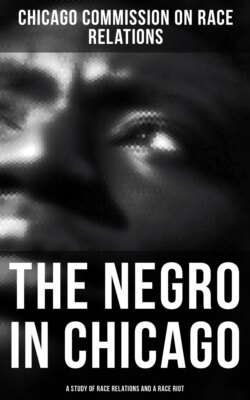Читать книгу The Negro in Chicago - A Study of Race Relations and a Race Riot - Chicago Commission on Race Relations - Страница 19
На сайте Литреса книга снята с продажи.
I. INTRODUCTION
ОглавлениеDuring the period 1916–18 approximately a half-million Negroes suddenly moved from southern to northern states. This movement, however, was not without a precedent. A similar migration occurred in 1879, when Negroes moved from Mississippi, Louisiana, Texas, Alabama, Tennessee, and North Carolina to Kansas. The origin of this earlier movement, its causes, and manner resemble in many respects the one which has so recently attracted public attention.
The migration of 1916–18 cannot be separated completely from the steady, though inconspicuous, exodus from southern to northern states that has been in progress since 1860, or, in fact, since the operation of the "underground railway." In 1900 there were 911,025 Negroes living in the North, 10.3 per cent of the total Negro population, which was then 8,883,994. Census figures for the period 1900–1910 show a net loss for southern states east of the Mississippi of 595,703 Negroes. Of this number 366,880 are found in northern states. Reliable estimates for the last decade place the increase of northern Negro population around 500,000.
The 1910–20 increase of the Negro population of Chicago was from 44,103 to 109,594, or 148.5 per cent, with a corresponding increase in the white population of 21 per cent, including foreign immigration. According to the Census Bureau method of estimating natural increase of population, the Negro population of Chicago unaffected by the migration would be 58,056 in 1920, and the increase by migration alone would be 51,538.
The relative 1910–20 increases in white and Negro population in typical industrial cities of the Middle West, given in Table II, illustrate the effect of the migration of southern Negroes.
The migration to Chicago.—Within a period of eighteen months in 1917–18 more than 50,000 Negroes came to Chicago according to an estimate based on averages taken from actual count of daily arrivals. All of those who came, however, did not stay. Chicago was a re-routing point, and many immigrants went on to nearby cities and towns. During the heaviest period, for example, a Detroit social agency reported that hundreds of Negroes applying there for work stated that they were from Chicago. The tendency appears to have been to reach those fields offering the highest present wages and permanent prospects.
| TABLE II | ||||
| Negroes | Percentage of Negro Increase, 1910–20 | Percentage of White Increase, 1910–20 | ||
|---|---|---|---|---|
| 1910 | 1920 | |||
| Cincinnati, Ohio | 19,639 | 29,636 | 50.9 | 8.0 |
| Dayton, Ohio | 4,842 | 9,029 | 86.5 | 28.0 |
| Toledo, Ohio | 1,877 | 5,690 | 203.1 | 42.5 |
| Fort Wayne, Ind. | 572 | 1,476 | 158.0 | 34.3 |
| Canton, Ohio | 291 | 1,349 | 363.6 | 71.7 |
| Gary, Ind. | 383 | 5,299 | 1,283.6 | 205.1 |
| Detroit, Mich. | 5,741 | 41,532 | 623.4 | 106.9 |
| Chicago, Ill. | 44,103 | 109,594 | 148.5 | 21.0 |
